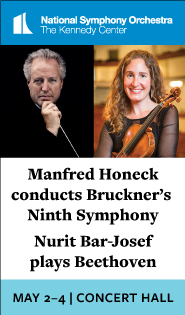Baltimore Symphony opens centennial season in rousing style with pie and Perlman

Itzhak Perlman performed the Mendelssohn Violin Concerto at the Baltimore Symphony Orchestra’s Centennial Gala Saturday night. Photo: Ricky O’Bannon
There was keen excitement in the Joseph Meyerhoff Symphony Hall Saturday night as the lights went down for the start of the Baltimore Symphony Orchestra’s 2016 Centennial Gala, conducted by music director Marin Alsop. This annual event celebrated both the kickoff of a new season for the BSO as well as marking the opening celebration of the orchestra reaching its century mark.
After a brief, rhythmically charged opening performed by a drumline of young musicians from the BSO OrchKids program, gala organizers took the stage to make an unusual announcement. Audience members were asked to take out their cell phones to participate in a live pledge drive tracked in real time by a screen above the stage, with the goal of raising thirty thousand dollars to aid BSO OrchKids. It is a testament to the dedication of the Baltimore audience that this goal was met and surpassed in minutes.
With phones turned off and returned to pockets and purses, the program proper began with the world premiere of Caroline Shaw’s The Baltimore Bomb. The title is a reference to a signature Baltimore dessert consisting of crumbled-up chocolate-fudge cookies and a vanilla chess filling baked into a pie crust.
Appropriately, this commissioned work by the Pulitzer-Prize winning American composer began with spoons clinking rhythmically on a plate. Out of this grew an effervescent swell of strings and winds, which Alsop steadily built into a sumptuous statement from the full orchestra. This brief climax subsided and diminished steadily and returned to the lone sound of spoons on plates to close the piece.

Music director Marin Alsop led the Baltimore Symphony Orchestra in the world premiere of Caroline Shaw’s “The Baltimore Bomb” Saturday night. Photo: Ricky O’Bannon
Having started with dessert, the audience was next treated to the evening’s main course– Mendelssohn’s Violin Concerto in E minor, performed by Itzhak Perlman.
The celebrated violinist began the work’s famous opening melody, one he has performed countless times throughout his career, with notable freshness and poetry, as if discovering it anew. After establishing his signature soulful tone in the lyrical passages of the first movement, Perlman charged into the daunting virtuoso passagework with ease and style, executing even the most demanding lines with a musicality that far surpassed mere technical showmanship. Perlman created true magic in the first movement’s short cadenza, imbuing high notes with striking beauty of tone.
The soloist’s mastery was deftly supported by the orchestra, led with sensitivity by Alsop, who expertly followed every twist and turn of Perlman’s phrasing. In the lush second movement, the ensemble provided a sumptuous cushion of sound to Perlman’s intimate melodic line, and created a gripping ebb-and-flow dialogue with the soloist in the stormier middle section.
Perlman played the invigorating finale with the brilliance and free spirit of a country fiddler, hopscotching through the technical challenges with dazzling ease. The entire work was instilled with a crystal-clear brightness and natural musicality that allowed the ingenuity of Mendelssohn to shine through.
Two Latin dances followed, keeping the energy level high—the “Malambo” from Alberto Ginastera’s dance suite Estancias, and the “Mambo” from Leonard Bernstein’s West Side Story. Though two distinct dances, the Mambo and Malambo share an infectious rhythmic vitality, as well as a common 6/8 meter. Alsop’s clever pairing allowed the contrast between the two to be heard as well.
Ginastera’s “Malambo” was played with a foundation of lush sound in the strings and a constant forte throughout, aided by a relentless drum line and vigorous brass. The Bernstein, while maintaining a ceaseless percussive beat, has sections of sparser instrumentation. Alsop took full advantage of the textural variety, creating bright bursts of different instrumental colorings.
The evening concluded with an arrangement by Nicholas Hersch of the “Ode to Joy” theme of Beethoven’s Ninth Symphony. Players from the OrchKids program and the Baltimore Symphony Youth Orchestra took the stage with the BSO, and Perlman returned to join the young musicians as well.
Hersch’s arrangement cut the majority of the finale and used no voices, instead simply introducing the famous melody before a somewhat jarring showcasing of the brass and percussion players from the OrchKids program. The young musicians played admirably well in terms of both sound quality and unity of ensemble under Alsop’s fluent direction.
JT Hassell is a Baltimore-based pianist. He completed high school at the Interlochen Arts Academy and is currently studying at the Peabody Conservatory.


